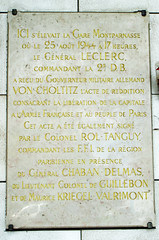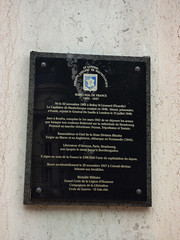Marshal Général Philippe Leclerc de Hauteclocque


Marshal Général Philippe Leclerc de Hauteclocque
(1902-1947)
French Army Général d'Armée and Marshal of France (from 1952)
Commemorated on 4 plaques
Libération de Paris (15 août - 28 août 1944). Ce bâtiment, siège de la Préfecture de Police, a été, le samedi 19 août 1944, le lieu du déclenchement de l'insurrection des Parisiens contre l'armée d'occupation allemande à l'initiative des mouvements de résistance de la police. Pendant plusieurs jours, des combats meurtriers se déroulent autour de ce immeuble et dans les rues de Paris où policiers, sapeurs-pompiers et gardes républicains, avec leurs camarades FFI et FTP, combattent l'occupant. 167 policiers perdent la vie lors de ces combats. Alors que la révolte est au bord de l'asphyxie, un appel de la Résistance parisienne est lancé, dès le 23 août, auprès du commandement allié pour aider le soulèvement parisien. Sur ordre du général Eisenhower, commandant suprême des forces alliées, et à la demand expresse du général de Gaulle, le général Leclerc, commandant la 2ème DB, marche sur Paris. Le 24 août, il adresse un message, largué par avion, aux insurgés: "Tenez bon, nous arrivons". Dans la soirée du 24 août et au matin du 25 août, la 2ème DB entre dans Paris, le général Leclerc arrive à la Préfecture de Police déjà libérée. A 15 h 30, le général von Choltitz, commandant du "Gross Paris", se rend à la Préfecture de Police où il signe la convention de reddition des forces allemandes de Paris avec le général de division Leclerc en présence de MM. Chaban-Delmas, Rol-Tanguy et Kriegel-Valrimont, représentant la Résistance. Cet acte de capitulation est rendu public en fin d'après-midi à la gare Montparnasse devant une foule enthousiaste. Par leur action, leur courage et leur sacrifice, les hommes et les femmes de la Résistance ont facilité la progression des éléments de la 2ème DB et de la 4ème division d'infanterie américaine pour la libération de la Capitale.
English translation: Liberation of Paris (15 August - 28 August 1944). On August 19, 1944, this building, the seat of the Prefecture of Police, was the scene of the insurrection of the Parisians against the German occupation army at the initiative of the police resistance movements. For several days, murderous fights took place around this building and in the streets of Paris, where police, firefighters and Republican guards, with their FFI and FTP comrades, were fighting the occupiers. 167 policemen lost their lives during the fighting. As the revolt is on the brink of asphyxia, a call from the Parisian Resistance is launched, as of 23 August, with the allied command to help the Paris uprising. On the orders of General Eisenhower, the Supreme Commander of the Allied Forces, and at the express request of General de Gaulle, General Leclerc, commanding the 2nd Armored Division, marched on Paris. On August 24, he sent a message, dropped by air, to the insurgents: "Hold on, we come." On the evening of August 24th and the morning of August 25th, the 2nd DB entered Paris, General Leclerc arrived at the Prefecture of Police, already liberated. At 3:30 pm General von Choltitz, commander of the "Gross Paris", went to the Prefecture of Police where he signed the agreement of surrender of the German forces in Paris with Major General Leclerc in the presence of Messrs. Chaban-Delmas, Rol-Tanguy and Kriegel-Valrimont, representing the Resistance. This act of capitulation is made public at the end of the afternoon at Montparnasse station before an enthusiastic crowd. Through their action, courage and sacrifice, the men and women of the Resistance facilitated the advance of the elements of the 2nd DB and the 4th Infantry Division for the Liberation of the Capital.
9 Boulevard du Palais, Paris, France where they was (1944)
Ici s'élevait la Gare Montparnasse où le 25 août 1944 à 17 heures, le Général Leclerc, commandant la 2e. D.B, a recu du Gouverneur militaire allemand Von Choltitz l'acte de reddition consacrant la libération de la capitale a l'Armée Française et au peuple de Paris. Cet acte a été également signé par le Colonel Rol-Tanguy, commandant les F.F.I. de la région parisienne en présence du Général Chaban-Delmas, du Lieutenant Colonel de Guillebon et de Maurice Kriegel Valrimont.
English translation: Here was the Gare Montparnasse where on August 25, 1944 at 5 pm, General Leclerc, commanding the 2nd. D.B, received from the German military governor Von Choltitz the act of surrender consecrating the liberation of the capital to the French army and the people of Paris. This act was also signed by Colonel Rol-Tanguy, commander of the F.F.I. of the Paris region in the presence of General Chaban-Delmas, Lieutenant Colonel de Guillebon and Maurice Kriegel Valrimont.
Gare Montparnasse, facing the rue de l'Arrivée, Paris, France where they was
Le General Philippe Leclerc de Hauteclocque Maréchal de France 1902 - 1947 Né le 22 novembre 1902 à Belloy St Léonard (Picardie) Le Capitaine de Hauteclocque combat en 1940, blessé, prisonnier, s'évade, rejoint le Général De Gaulle à Londres le 15 juillet 1940. Jure à Koufra, conquise le ler mars 1941 de ne déposer les armes que lorsque nos couleurs flotteront sur la cathédrale de Strasbourg. Poursuit sa marche victorieuse: Fezzan, Tripolitaine et Tunisie. Rassembleuer et Chef de la 2ème Division Blindée forée au Maroc et en Angleterre, dé,barque en Normandie (1944). Libérateur d'Alençon, Paris, Strasbourg, son épopée le mène jusqu'à Berchtesgaden. Il signe au nom de la France le 2/09/1945 l'acte de capitulation du Japon. Meurt accidentellement le 28 novembre 1947 à Columb-Béchar. Inhumé aux Invalides. Médaille Militare Grand Croix de le Légion d'Honneur Compagnon de la Libération Croix de Guerre - 12 fois cité.
English translation: The General Philippe Leclerc de Hauteclocque Marshal of France 1902 - 1947 Born on November 22, 1902 in Belloy St Léonard (Picardy) The Captain of Hauteclocque fought in 1940, wounded, prisoner, Escapes, joined General De Gaulle in London on 15 July 1940. Jure at Koufra, conquered on 1 March 1941 not to lay down the arms That when our colors float on the cathedral of Strasbourg. Continues its victorious march: Fezzan, Tripolitania and Tunisia. Gather and Lead the 2nd Armored Division Drilled in Morocco and England, deck, bark in Normandy (1944). Liberator of Alençon, Paris, Strasbourg, his epic leads him to Berchtesgaden. He signed on behalf of France on 2/09/1945 the act of capitulation of Japan. Accidentally died on 28 November 1947 in Columb-Béchar. Buried at the Invalides. Military Medal Grand Cross of the Legion of Honour Companion of the Liberation Cross of War - 12 times quoted.
Monument des enfants du Rhône - Parc de la Tête d'Or, Lyon, France where they was
A la mémoire du général LECLERC de HAUTECLOCQUE né à Belloy St Léonard (Somme). Libérateur de la patrie 1902-1947. La population d'Amiens reconnaissante par le combat et la victoire du Tchad au Rhin par Paris et Strasbourg.
English translation: In memory of General Lleclerc de Hauteclocque born at Belloy St Léonard (Somme). Liberator of the Fatherland 1902-1947. The population of Amiens grateful for the fight and the victory of Chad to the Rhine by Paris and Strasbourg.
, Amiens, France where they was born near (1902)



